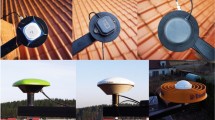Abstract—
Accuracy of range measurements using navigation satellites primarily depends on on-board clock correction parameters which are broadcasted to users periodically. The on-board clock offset, a critical correction parameter which accumulates due to fractional frequency offset as well as frequency drift, has to be maintained within the allocated broadcast limit throughout the satellite’s service. In IRNSS satellites, the clock offset is maintained within the broadcast limit by applying frequency offset corrections to the on-board atomic clock monitoring unit. In this paper, we discuss the methodology implemented for computing the clock offset using one-way range measurement data. Further, we report the time keeping methodology employed in IRNSS satellites that enables maintaining the satellite clock offset within the broadcast limit with minimum number of intervening frequency offset corrections throughout their operational life time.






Similar content being viewed by others
REFERENCES
Mallette, L.A., White, J., and Rochat, P., Space qualified frequency sources (clocks) for current and future GNSS applications, IEEE/ION Position, Location and Navigation Symposium, 2010, pp. 903−908.
Liu, C., Xu, F., Qu, Y., Zhang, Y., Du, E., Cheng, M., Tang, T., and Zhang, W., Analysis on factors influencing frequency drift of rubidium clocks for satellite navigation, China Satellite Navigation Conference (CSNC) Proceedings: Volume III. Lecture Notes in Electrical Engineering, Springer, Singapore, 2016, vol. 390, pp. 645−652.
Navstar GPS Space Segment/Navigation User Segment Interfaces, Interface Specification, (Global Positioning Systems Directorate, California 2013), IS-GPS-200H, 2013.
Epstein, M., and Dass, T., Management of phase and frequency for GPS IIR satellites, 33rd Annual Precise Time and Time Interval (PTTI) meeting, The University of New South Wales, 2001, pp. 481−492.
Phelan, J., Dass, T., Freed, G., Rajan, J., D’Agostino, J., and Epstein, M., GPS block IIR clocks in space: Current performance and plans for the future, Proceedings of the IEEE International Frequency Control Symposium and Exposition, 2005, pp. 19−25.
Huang, G., Cui, B., Zhang, Q., Li, P., and Xie, W., Switching and performance variations of on-orbit BDS satellite clocks, Advances in Space Research, 2019, vol. 63, no. 5, pp. 1681−1696.
Geng, T., Jiang, R., Lv, Y., and Xie, X., Analysis of BDS-3 onboard clocks based on GFZ precise clock products, Remote Sensing, 2022, vol. 14, no. 6, pp.1389.
Kudrys, J., Prochniewicz, D., Zhang, F., Jakubiak, M., and Maciuk, K., Identification of BDS satellite clock periodic signals based on Lomb-Scargle power spectrum and continuous wavelet transform, Energies, 2021, vol. 14, no. 21, pp. 7155.
Ganeshan, A.S., Ratnakara, S. C., Nirmala, S., Babu, R., Neetha, T., and Kartik, A., Successful proof-of-concept demonstration first position fix with IRNSS, Inside GNSS, 2015, vol. 10, no. 4, pp. 48−52.
Ganeshan, A.S., Ratnakara, S.C., Gupta, R., and Jain, A.K., Indian Regional Navigation Satellite System (IRNSS) concept, Journal of Spacecraft Technology, 2005, vol. 15, no. 2, pp. 19−23.
Rajaiah, K., Manamohan, K., and Nirmala, S., IRNSS/NavIC on-board time synchronization with ground reference time, Journal of Spacecraft Technology, 2020, vol. 31, no. 2, pp. 01–05.
Indian Space Research Organisation, Indian Regional Navigation Satellite System, Signal In Space ICD for Standard Positioning Service, Version 1.1, U.R. Rao Satellite Centre, Bangalore, ISRO-IRNSS-ICD-SPS-1.1, 2017.
Huayi Zhang, Shengyue Ji, Zhenjie Wang, and Wu Chen, Detailed assessment of GNSS observation noise based using zero baseline data, Advances in Space Research, 2018, vol. 62, no. 9, pp. 2454−2466.
Misra, P., and Enge, P., Global Positioning System: Signals, Measurements and Performance, revised second edition, Lincoln, Mass.: Ganga-Jamuna Press, 2001.
Hatch, R., The synergism of GPS code and carrier measurements, Proceedings of 3rd International Geodetic Symposium on Satellite Doppler Positioning, New Mexico State University, 1982, vol. 2, pp. 1213–1231.
Qinghua Zhang, Zhengsheng Chen, Fengjuan Rong, and Yang Cui, An improved Hatch filter and its application in kinematic positioning with single-frequency GPS, Measurement, 2019, vol. 146, pp. 868−878.
Rajaiah, K., Manamohan, K., Nirmala, S., and Ratnakara, S.C., Modified empirical solar radiation pressure modelling for IRNSS, Advances in Space Research, 2017, vol. 60, no. 10, pp. 2146–2154.
Saastamoinen, J., Atmospheric correction for troposphere and stratosphere in radio ranging of satellites, Geophysics Monograph Series, American Geophysical Union, 1972, vol. 15, pp. 247−251.
ACKNOWLEDGMENTS
The authors would like to acknowledge all the members of Space Navigation Group, U.R. Rao Satellite Centre, Bangalore for their motivation and help in carrying out the work discussed in this paper. This work is supported and funded by Indian Space Research Organisation (ISRO), India.
Author information
Authors and Affiliations
Corresponding authors
Rights and permissions
About this article
Cite this article
Rajaiah, K., Manamohan, K., Nirmala, S. et al. Satellite Time Keeping Methodology for IRNSS/NavIC Constellation. Gyroscopy Navig. 13, 149–154 (2022). https://doi.org/10.1134/S2075108722030075
Received:
Revised:
Accepted:
Published:
Issue Date:
DOI: https://doi.org/10.1134/S2075108722030075




